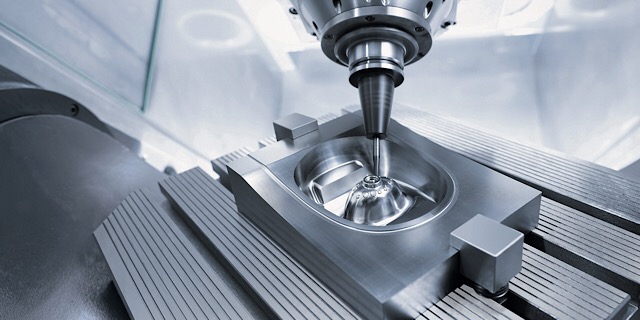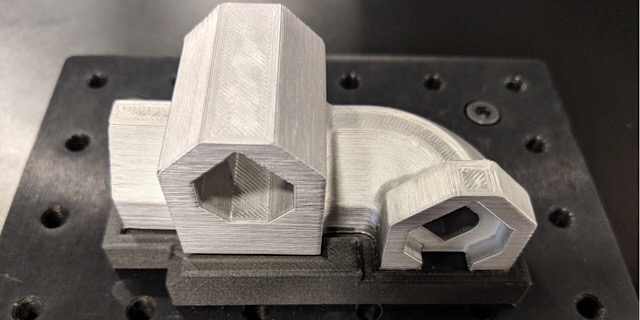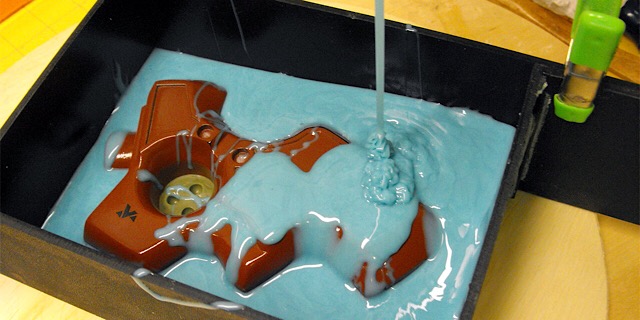Rapid tooling is a considerably new manufacturing process that has been developed when small batch customized parts became widespread. The demand for such parts established flexible technological processes, where manufacturing preparation must be as short as possible, so tooling production had to be shortened.
The manufacturing process of conventional tooling is quite similar to the manufacturing of low-batch commercial parts. Depending on the technical requirements, a blank is either cast, forged or just bought (chosen as a cylinder from the standard diameter list). It is then machined, heat-treated to increase its durability and then ground and finished using precision manufacturing techniques.
Overall, depending on the complexity and the number of parts, manufacturing, take a plastic injection mold, for example, requires months. Therefore, sometimes it is better to use less time and manufacture the tooling with worse properties, however, that those are enough to make a prototype or a test-batch of the product.
Molding and Casting are specialized vowin.cn' target='_blank'>rapid prototyping process for which meet specific application and material requirements. However, vowin.cn/' target='_blank'>rapid tooling processes and methods have normally forms including Sla and Sls that developed for specific applications.
Although material properities improve and increase continiously, applications are unlimited. Therefore, it cannot avoid transfering materials that have been used in some parts fabricated in rapid tooling process into another materials. With the injection molding technolgy improves, several material transfer technologies have been developed for using specific to make most tools
Rapid Tooling technologies are currently developing from a scientific concept into a commercial industry. The Rapid Tooling processes are currently used by the frontline prototyping companies to further decrease the lead-time of the product. The difficulty in tooling manufacturing is in combining the multitude of manufacturing techniques with the design possibilities they enable and part properties they provide. Due to a lack of research in the Rapid tooling processes, repeatability is also a big issue that has to be assessed yet.
Despite the novelty of rapid tooling, a significant number of rapid manufacturing techniques exist nowadays. A lot of them have descended from the rapid prototyping technologies, however, with some changes. The precision and durability requirements towards tooling are much higher than for simple prototypes. So, here is a list of the most significant Rapid Tooling techniques.

CNC machining is the most conventional of Rapid tooling techniques. The development of CNC systems has made the machining processes much more flexible and lead time much shorter. The need for specialized fixtures is gone since the probes can determine the exact position and dimensions of the blank.
Any kind of surface can be manufactured with a very tight tolerance (up to a few microns) on the 5-Axis machine tools. Rapid machining services make it possible to order a prototype or a small batch without the need to invest in expensive equipment.
Overall, this method is one of the best in terms of precision and available material range. CNC parts, however, have some limitations when it comes to cavities. It is hard to manufacture sharp edges and deep grooves.

Additive manufacturing is one of the newest processes that found its use among the Rapid Tooling techniques. There are different additive processes but the most widely used ones for tooling are bed fusion and direct metal deposition. Both of them use metal powder sintered together layer-by-layer to obtain the desired part.
The main advantage of 3D printing is its unprecedented flexibility. You need no fixtures at all and you do not require blanks. The metal powder is universal. You can also create sharp corners and cooling channels that are impossible to make using other processes. The downside of the process is that the surface quality is not very good, so you will have to spend some time post-processing.

When manufacturing plastic prototypes or low-volume batches, producing conventional injection molds is too long and expensive. So, soft tooling is manufactured instead. The process requires a master-model that has to be manufactured either manually (wood will do) or by 3D-printing or CNC prototype machining. The master part is suspended over the tank and liquefied silicone is poured over it. Once the silicone hardens, it is cut in half and the master model is ejected. The result is an injection mold made of silicone that can withstand up to 15 uses.

Electrical Discharge Machining is indispensable when your tooling has to be made of very hard material. For example, some dies that are used to manufacture titanium alloy parts withstand tremendous stresses even when prototypes are manufactured. So, instead of spending a ton of time cutting small chips off the blank using a milling center, it is more preferable to make a reversed cavity form on a softer material (aluminum or copper) and install it as a tool on an EDM machine.
EDM employs electrical discharges between the blank (the future titanium dies) and the tool (copper with the reversed cavity). Small titanium particles are evaporated due to the discharges and the tool is lowered thus creating the cavity in the titanium much faster.
Using intermediate tooling to produce a small quantity of prototypes or functional tests is a key process to the product development cycle. Rapid tooling plays great role during marketing samples, evaluation purposes, and production process design.
We all know that creating a mold with rapid tooling is not always helping to save lots of time. When it comes to mold manufacturing, rapid tooling is typically faster than traditional machining of steel or aluminum, but the process of finishing touches that maybe can slow your process down once the mold is shaped or created.
If you have any questions about creating low-volume molded plastic parts, please feel free request a quote and our experts will be in touch with you as soon as possible
The rapid tooling processes are very promising in the current era of customized goods. That is why a lot of companies invest in research that concerns itself with inventing new ways to rapidly manufacture tooling.Existing processes are being constantly improved as well. Only a few years ago we couldn't dream of using printed parts for anything rather than models but now, functional printed parts are used in a wide range of different machines.
CNC precision, materials and speeds are being improved as well. New cutting speeds are reached every year and the improvements are only growing at a rapid rate.
Same things can be said for soft tooling Silicone molds are being cured in the oven now to increase their durability. New plastics are being constantly developed.
RT will soon move from prototypes and single parts into full-scale mass production.
During the trade disputes, the united states unreasonably imposes heavy taxes on machining industry. As we know, since the mold industry can be regardes as "the mother of manufacturing", it must be a heavy strike for us to rely on the advantages of price in an old way. On the contrary, trade dispute is a good news for America that exports high quality moulds with high precision and high-tech, they can eaily defeat us on price reasons while not influced more under our revenges.
Although China's mold industry takes leads in yeilds and exports, but whatever it refers to the level of design and making is much lower than America, we can take for the lifetime of molds as an example. It suggested that domestic mold companies take proactive polices to industry upgrading while abanding the old teeth of price advantages.
1.Lift improvement to the mold industry techniques.With coming up with Made in China 2025, more and more companies have passed quality system certification so as to embrace new situation.Besides, these companies combine CAD/CAE/CAM & 3D techiniques with ERP & IM3, some revolutionary cool-tech include High speed machining, rapid prototyping,visual simulation,robotics and smart manufacturing have been applied to mold maching industry.
2.Optimize scale of mold machining bases.With the increasing demands from domestic and abroad, tradtional mold workshops must improve the modes of managements towards larger direction.In recent years, Mold city, Mold park, Mold production bases etc have rapidly spread in the whole national, thus creating the strinking scale of economy and industrial clusters.
3.Attach great importance to Brand and Patent and strengthen innovation and research and development.With the development market-economy, some entreprenuial enterprises and star-ups have come to realize their importance of innovation and R&D and input more investment, because they think brand and pattern have become the development trend of molding industry in the future.
4.Provide more Support for mold industry personnel trainings.In recent years,although staffs are increasing employed by China's molding industry, we still cannot catch up with the requirements of industry for which lacking for related enterprised managers, middle and senior techinical personnels with high quailty. So, quality and numbers of talents will be our persuit.


